


|
The �Zen� Dining Experience
|
|
THERE is a new generation Chinese restaurant in town with an indiscreet name, that has incongrous interiors, and a menu that is, well, daring. It is called Henry Tham, after its owner, and as you may imagine, it is not a Chinese-Chinese restaurant at all. No red-and-green lanterns and dancing golden dragons on the walls. No a la carte menu with chop suey and fried rice; in fact, the tables do not even have the de rigeur soya-vinegar-chilli sauce bottles on them. And no smiling and bowing Chinese waiters, the hostesses are Manipuri, the service attendants include Muslims and Maharashtrians. That�s how bold and different this restaurant is.
There�s more. Like, Henry Tham has set menus for vegetarian and non-vegetarian food. And dishes made with such unfamiliar ingredients as wasabi mayonaise, garlic foam, pink peppercorns, cheese and miso. Some dishes on the menu, like the Martini-stewed lamb shanks topped with creamy garlic foam, had me asking mine host in wonder what was Chinese about them. �Nothing,� the restaurateur Henry Tham airily replied, being casually dismissive. �And would you describe a miso-soya soup with tofu and seaweed as being Chinese food,� I asked, still amazed. �Well it fits in well with the whole dining experience,� he replied cleverly. �And Chinese food is so adaptable. It instantly takes on local flavours. Indian Chinese food cannot be compared to that in, say, Singapore or Indonesia, you know.�
That is true. And so, the only thing familiar to me about the restaurant was its location. It is Chinese restaurateur Moon Yu Tham�s old Mandarin at Dhanraj Mahal in Apollo Bunder. I must warn you. If you are looking for a
I dined with Henry one Saturday night. Farzana Contractor was luckier. She met the entire Tham family a short while before me. There was Henry, his ageing father Moon Yu Tham, and his sons Ryan and Keenan, the third generation Tham family Chinese restaurateurs. Old man Tham rarely steps out. His days of running a Chinese eatery ended when the family shut down Mandarin in 1999 for renovations. But, he made the exception to come and see Farzana, she being an old friend. I had Henry at my table and his lovely wife Ashita on the phone, wanting to know when he was coming home, while Ryan and Keenan looking like young Hong Kong pop singers or movie stars took care of the service.
Henry shared a secret with me. �The glasses are very expensive, but wine is in the realm of being stylish, people notice the table settings with the glasses and want to experience drinking wine out of them,� he said. What a clever idea!
If Moon Yu Tham had vision in 1969 when he opened Mandarin (and Kamling in Churchgate) and sold it as a complete dining experience with cabaret shows, limbo dancers, and a magician and ventriloquist who performed while diners ate and dwarfs wrestled on the floor, then Henry has class and style and experience. He got the Total Integrated Design company of Singapore to redesign the Mandarin and the Tung Luk Group, also of Singapore, to work as its consultant. He was fortunate. The Tung Luk Group, which has 20 high-end restaurants of all types, including ones specialising only in dim sums and seafood, traditional and modern, was looking at expanding outside Sigapore. It had selected China and India as its hunting ground. Henry told them, �I don�t want a partner, but I�m searching for a consultant who can give me Chinese food with contemporary appeal, I�m looking at setting a
fine wining and dining Chinese trend in India.�
I will not attempt to describe the food. It is an experience you go through. But, yes, I would recommend you have the Martini-stewed lamb shanks (�not stirred�), cooked slowly for hours like a nihari in a Muslim restaurant to ultimate softness and topped with creamy garlic foam. Also the king prawns coated in yellow soyabean paste and Chinese rice wine that are grilled or the white prawns glazed with wasabi mayo. And, an indulgence, the platter of beans, stir-fried greens with mushrooms that is served with steam rice and an entree of your choice: there is prawn, tenderloin, chicken and unagi.
Which Chinese restaurant can give you that experience! Or choice?
Henry Tham
|

Home Page
About the mag
Subscribe
Advertise
Contact Us
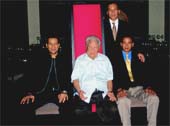 Bombay�s Chinese restaurateur Henry Tham wanted his new restaurant to be contemporary, timeless and Zen-like, he told MARK MANUEL, who went eating out there.
Bombay�s Chinese restaurateur Henry Tham wanted his new restaurant to be contemporary, timeless and Zen-like, he told MARK MANUEL, who went eating out there.
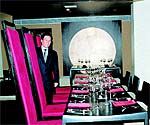 regular Chinese meal, I would suggest you go to Baba Ling�s Pavilion across the road. Or even the new Golden Dragon at the Taj. But if you want a new experience in Oriental dining, with fine wines from Chateau Laffitte and Nederburg Estate served in impressive Schott glasses, and with a Japanese singer crooning English love songs in the background, then go to Henry Tham. The restaurant is spanking new, and it is open only for dinner, call and reserve a table or you may be left waiting outside indefinitely with a night view of the illuminated Gateway in the background.
regular Chinese meal, I would suggest you go to Baba Ling�s Pavilion across the road. Or even the new Golden Dragon at the Taj. But if you want a new experience in Oriental dining, with fine wines from Chateau Laffitte and Nederburg Estate served in impressive Schott glasses, and with a Japanese singer crooning English love songs in the background, then go to Henry Tham. The restaurant is spanking new, and it is open only for dinner, call and reserve a table or you may be left waiting outside indefinitely with a night view of the illuminated Gateway in the background.
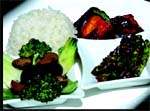 Henry, who is unusually introverted even for a Chinese, was in an expansive mood that night. He changed my wine, a Villa Maria Sauvignon Blanc 2002 for a Nederburg Chardonnay 200, because, he said, it went better with the food. I did not argue because I was unfamiliar with the food. When a Chinese menu includes steamed Garoupa fish flavoured with garlic and spring onion; tenderloin with beans, stir-fried greens, mushrooms and rice; and, grilled king prawns coated with yellowbean paste and Chinese rice wine, then I don�t know what to order. The wine glasses are Schott Zwiesel, Rosenthal and the hand-made Polish LSA. And the wines have been selected by UpperCrust wine consultant Asit Chandmal. While our Chardonnay was being poured in huge Schott bubble glasses,
Henry, who is unusually introverted even for a Chinese, was in an expansive mood that night. He changed my wine, a Villa Maria Sauvignon Blanc 2002 for a Nederburg Chardonnay 200, because, he said, it went better with the food. I did not argue because I was unfamiliar with the food. When a Chinese menu includes steamed Garoupa fish flavoured with garlic and spring onion; tenderloin with beans, stir-fried greens, mushrooms and rice; and, grilled king prawns coated with yellowbean paste and Chinese rice wine, then I don�t know what to order. The wine glasses are Schott Zwiesel, Rosenthal and the hand-made Polish LSA. And the wines have been selected by UpperCrust wine consultant Asit Chandmal. While our Chardonnay was being poured in huge Schott bubble glasses, 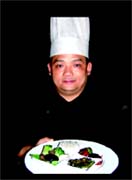 Both the Singapore-based companies were happy to collaborate and work with him. The Total Integrated Design company, acting on his brief, has given Henry Tham a modern interior that has a timeless, zen-like look. Henry fancied tall-backed chairs, they gave him that. He explained the seating arrangements to me: �It had to be tall chairs because everything else in a Chinese restaurant is horizontal. I wanted a vertical feel to the place. Therefore, tall chairs and tall glasses. It�s not quirky. It�s a fun element of something arising.� And, among the tall chairs, Henry Tham has a floor-style Japanese seating upstairs that I understand is most popular with even the stiff-legged among Bombay�s gentry. On the tables, among the aforementioned glasses, is assorted tableware from Hutschen Reuther, Basucher, some Japanese dishes in various shapes, and cultery from Ercuis of France.
Both the Singapore-based companies were happy to collaborate and work with him. The Total Integrated Design company, acting on his brief, has given Henry Tham a modern interior that has a timeless, zen-like look. Henry fancied tall-backed chairs, they gave him that. He explained the seating arrangements to me: �It had to be tall chairs because everything else in a Chinese restaurant is horizontal. I wanted a vertical feel to the place. Therefore, tall chairs and tall glasses. It�s not quirky. It�s a fun element of something arising.� And, among the tall chairs, Henry Tham has a floor-style Japanese seating upstairs that I understand is most popular with even the stiff-legged among Bombay�s gentry. On the tables, among the aforementioned glasses, is assorted tableware from Hutschen Reuther, Basucher, some Japanese dishes in various shapes, and cultery from Ercuis of France.
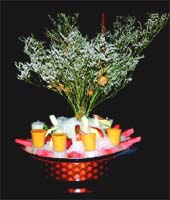 Now for the food. The eating out experience at Henry Tham goes beyond food. It is more to do with styling of the cuisine and presentation. Cooking the food is easy, I suppose, but pairing it so that the flavours are simple, light, the dish is not too saucy or spicy, and with exaggerated flavours, so that diners feel they are eating a �Chinjabi� meal of Chinese and Punjabi influences, is what goes down big with Henry Tham. The dish when it comes on your table is pleasing to the eye. And that, as Henry says, is one half of the exercise. He and Executive Chef Dominic Ho worked with the Tung Luk experts on producing a menu that was a synergy of both their expertise. �But the final selection was made here and we tweaked the cooking part a bit,� explained Henry. �It is a departure from the Bombay Chinese experience. This is Henry Tham food. It is Chinese-based. It is light and fresh food. I would not call it nouvelle, that�s too passe a word, it is food I like and which I am sure people will be happy to eat.�
Now for the food. The eating out experience at Henry Tham goes beyond food. It is more to do with styling of the cuisine and presentation. Cooking the food is easy, I suppose, but pairing it so that the flavours are simple, light, the dish is not too saucy or spicy, and with exaggerated flavours, so that diners feel they are eating a �Chinjabi� meal of Chinese and Punjabi influences, is what goes down big with Henry Tham. The dish when it comes on your table is pleasing to the eye. And that, as Henry says, is one half of the exercise. He and Executive Chef Dominic Ho worked with the Tung Luk experts on producing a menu that was a synergy of both their expertise. �But the final selection was made here and we tweaked the cooking part a bit,� explained Henry. �It is a departure from the Bombay Chinese experience. This is Henry Tham food. It is Chinese-based. It is light and fresh food. I would not call it nouvelle, that�s too passe a word, it is food I like and which I am sure people will be happy to eat.�